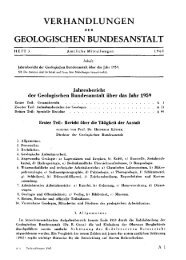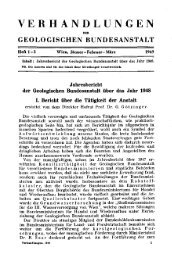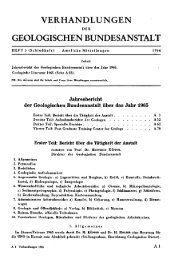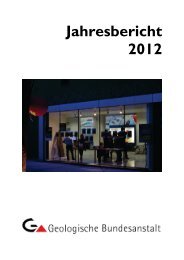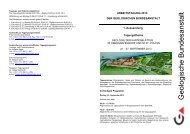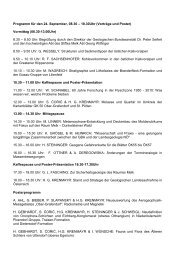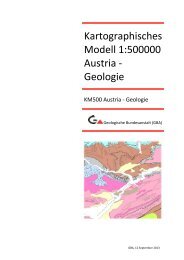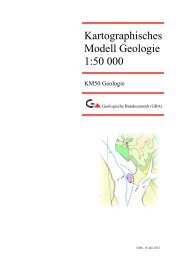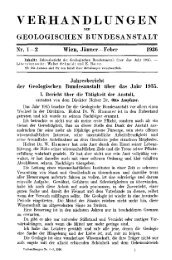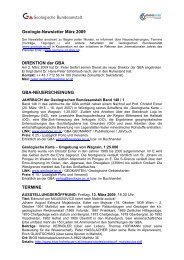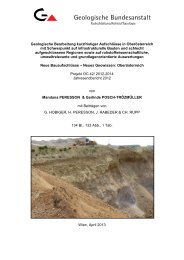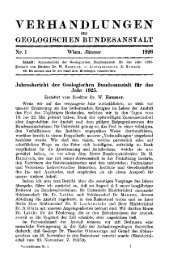Field Trip B TRIASSIC CONODONT LOCALITIES OF THE ...
Field Trip B TRIASSIC CONODONT LOCALITIES OF THE ...
Field Trip B TRIASSIC CONODONT LOCALITIES OF THE ...
Create successful ePaper yourself
Turn your PDF publications into a flip-book with our unique Google optimized e-Paper software.
lella tethydis and Gondolella polygnathiformis.<br />
With a distinct change in facies the fore-mentioned fossil bed is overlain by a bed of „Rotkalk" with<br />
varying thickness (between 20 cm and maximally 80 cm) which can be traced in the whole quarry. The<br />
surface of this bed is characterized by a several cm high small-scaled relief plombed by small lenses of<br />
„Rotkalk" and iron-manganese crusts. From here a rich ammonite fauna is recorded indicating the uppermost<br />
Tuvalian Anatropites-Jiereich (e. g., Anatropites spinosus, Discotropites plinii, Thisbites; for<br />
reference see KRYSTYN 1973, p. 117). Since this fauna indicates the presence of both subzones some<br />
condensation must be assumed.<br />
From this bed two conodont samples were collected, the first close to the base and the second<br />
from the top. The lower one (70/67) contains rare G. polygnathiformis and G. nodosa in an almost<br />
equal ratio and clearly points to the Tuvalian 3. In the upper sample (70/78) a rich fauna was found<br />
composed of G. polygnathiformis, G. nodosa, M. communisti and E. primitia. This fauna represents a<br />
mixture of otherwise two distinct conodont assemblages (see fig. 9). The unusual composition must be<br />
due to condensation as is suggested by the ammonite fauna too. From level 70/78 the holotype of ,,Metapolygnathus<br />
spatulatus pseudodiebeli" (KOZUR 1972, pi. 4, fig. 5) is derived.<br />
During the lowermost Norian the western part of the quarry supposedly was located at the summit<br />
of a small submarine ridge. Some 100 m to the east in section B (fig. 11) the „Rotkalke" of the Jandianus<br />
Zone reach a thickness of 8 m; in section Fl-E the thickness decreases to 2 m and in section Fl-<br />
W to less than 50 cm! Lowermost Norian strata (Lacian 1/1) are completely missing in F1-W whereas<br />
in section Fl-E they are represented by a 1,60 m thick limestone bed with Halobia austriaca. Two conodont<br />
samples from the base and from near the top produced the following taxa:<br />
76/80: M. communisti morphotype A (3 x),M. communisti morphotype B (53 x),E. abneptis (7 x).<br />
77/39: M. communisti morphotype B (3 x), E. primitia (25 x), E. abneptis (7 x), G. navicula (2 x).<br />
In section Fl-W the upper Lacian 1 is represented by the „Rotkalk"-bed 70/40 and the overlying<br />
lumachelle bed with Halobia styriaca (70/50). Within the lumachelle bed a shallow fissure filling of<br />
„Rotkalk" occurs which contains a rich but tiny ammonite and gastropod fauna (70/51). In addition<br />
to the fauna listed in KRYSTYN 1973, p. 118 Guembelites philostrati DIENER and Griesbachites<br />
medley anus (STOLIZKA), two index species of the Lacian 1/II-Subzone were found. The latter also occurs<br />
in the lumachelle bed proper. The conodont fauna of both beds is identical and comprises E. primitia,<br />
E. abneptis and G. navicula.<br />
Above the Styriaca-lumachelle lithology changes to a more fine grained, light to pink coloured, irregularly<br />
thick bedded limestone, the so-called „Massiger Hellkalk". Yet, no fossils have been found at<br />
this place. However, this facies change also occurs in the quarries F4 and F5 where it is proved by ammonites<br />
to take place at the boundary from the Jandianus to the Paulckei Zones. In quarry Fl-W the<br />
sample 70/80 yielded E. primitia (2 x), E. abneptis (4 x) and a large number of G. navicula (60 x). This<br />
bed most probably is the stratum typicum of G. navicula as described by HUCKRIEDE 1958, p. 114<br />
(sample 49 c).<br />
Section B (see fig. 11) offers the possibility to collect reference material from the lowermost Norian<br />
and the uppermost Tuvalian, depending that the latter will be exposed during the excursion. The<br />
two marker horizons A and B indicate the Tuvalian/Lacian boundary and the boundary between Lacian<br />
1/1 and l/II respectively. Except the rich occurrence of Halobia austriaca in many beds megafossils are<br />
lacking in this part of the section. The rich conodont fauna exhibits a distinct vertical sequence from<br />
M. communisti morphotype A to M. communisti morphotype B; this transition has been traced shortly<br />
above the Karnian/Norian boundary.<br />
Quarries F 4 and F 5 (Subbullatus and Paulckei-Lager)<br />
The two quarries F 4 and F 5 are located on the north side of Feuerkugel at an altitude of approx.<br />
1590 m hidden by dwarf-pines. Previously, quarry F 4 was described by KRYSTYN & SCHLAGER<br />
1971 and KRYSTYN 1973. Quarry F 5 has been open since 1973; it is situated about 30 m to the west<br />
of F 4. This quarry was made to improve fossil collecting and also, to examine the complicated sequence<br />
exposed in quarry F 4. Subsequent study of this quarry in 1973 and 1977 provided more detailed<br />
information about the sequence (see KRYSTYN 1974 a).<br />
Correlation between both quarries has been achieved on a bed by bed study. The two fossil sites<br />
accumulated in a graben-like structure which had formed from the Upper Karnian to the Lower Norian.<br />
The extension of the graben is at least 4 x 50 m. Faster subsidence of the northern edge resulted in<br />
differentially north dipping sediments whereas in the southern part a thinning of individual beds can<br />
85



